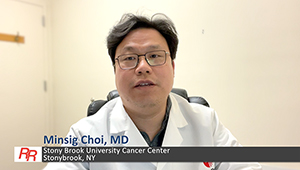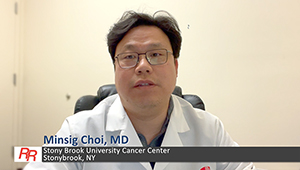Based on favorable survival data from the randomized, global, 3-arm, phase 3 CheckMate 649 study that compared the first-line programmed death 1 (PD-1) inhibitor nivolumab (NIVO) + chemotherapy versus chemotherapy alone in patients with advanced non–HER2-positive gastric cancer (GC)/gastroesophageal junction cancer (GEJC)/esophageal adenocarcinoma (EAC), NIVO + chemotherapy was approved in the United States and other countries. Expanded analyses of NIVO + chemotherapy versus chemotherapy alone with a minimum follow-up of 24 months were presented at the 2022 American Society of Clinical Oncology Gastrointestinal Cancers Symposium.
The CheckMate 649 study enrolled adults with previously untreated, unresectable advanced or metastatic GC/GEJC/EAC, no known HER2-positive status, Eastern Cooperative Oncology Group (ECOG) performance status (PS) 0-1, regardless of PD ligand 1 (PD-L1) expression. Eligible patients were randomized to receive 3 therapies: (1) NIVO (360 mg every 3 weeks or 240 mg every 2 weeks) + chemotherapy (XELOX every 3 weeks or FOLFOX every 2 weeks); (2) NIVO 1 mg/kg + ipilimumab 3 mg/kg every 3 weeks (4 doses, then NIVO 240 mg every 2 weeks); or (3) chemotherapy (XELOX every 3 weeks or FOLFOX every 2 weeks).
Stratification was based on tumor cell PD-L1 expression (≥1% vs <1%), region (Asia vs United States/Canada vs rest of the world), ECOG PS (0 vs 1), and chemotherapy (XELOX vs FOLFOX). Dual primary end points were overall survival (OS) and progression-free survival (PFS) per blinded independent central review in patients with PD-L1 combined positive score (CPS) ≥5 for NIVO + chemotherapy versus chemotherapy alone; hierarchical secondary end points included OS in NIVO + chemotherapy versus chemotherapy alone (PD-L1 CPS ≥1, then all randomized). Data cutoff date was May 27, 2021.
A total of 2031 patients were enrolled in the study; of these, 789 patients received NIVO + chemotherapy and 833 patients received chemotherapy alone. In all randomized patients, the patient and disease characteristics were well-balanced; a similar proportion of patients in the NIVO + chemotherapy versus chemotherapy-alone arms received subsequent therapy (41% vs 44%), including systemic anticancer therapy (37% vs 42%).
In all randomized patients (n = 1581), with longer follow-up, clinically meaningful improvement in OS (13.8 vs 11.6 months; hazard ratio [HR], 0.79; 95% confidence interval [CI], 0.71-0.88) and PFS (7.7 vs 6.9 months; HR, 0.79; 95% CI, 0.70-0.89) was maintained with NIVO + chemotherapy compared with chemotherapy. NIVO + chemotherapy was associated with favorable PFS2, defined as time from randomization to progression after subsequent systemic therapy, initiation of second subsequent systemic therapy, or death (12.2 vs 10.4 months), and produced a 25% reduction in risk of death or progression on subsequent therapy (HR, 0.75; 95% CI, 0.67-0.84). Compared with chemotherapy, OS benefit with NIVO + chemotherapy was observed across various key subgroups, including age, ECOG PS, primary tumor location, baseline tumor burden, chemotherapy regimen received, and microsatellite instability (MSI) status.
In patients with PD-L1 CPS ≥5 (n = 955), OS benefit favored NIVO + chemotherapy overall versus chemotherapy alone (13.8 vs 11.6 months; HR, 0.78), which extended to all PD-L1 CPS subgroups analyzed but was enriched at higher PD-L1 CPS cutoffs. Among patients with a PD-L1 CPS ≥10 (n = 767), NIVO + chemotherapy was associated with a 34% reduction in risk of death (median OS, 15.0 vs 10.9 months; HR, 0.66) versus chemotherapy. Higher objective response rate (ORR) was achieved with NIVO + chemotherapy across all evaluated PD-L1 CPS subgroups, with deeper and durable responses achieved independent of PD-L1 CPS ≥5 or <5. OS and ORR benefit across PD-L1 CPS subgroups was consistent with all randomized patients when excluding patients with MSI-high tumors. A higher proportion of patients who received NIVO + chemotherapy achieved >50% reduction from baseline in tumor burden (51% vs 43%); 24% of patients in the NIVO + chemotherapy cohort achieved >80% reduction compared with 17% of patients in the chemotherapy-alone cohort.
With longer follow-up, no new safety signals with NIVO + chemotherapy were identified. The most common grade 3/4 treatment-related adverse events (TRAEs) with NIVO + chemotherapy included neutropenia (15%), decreased neutrophil count (11%), and anemia (6%). The majority of immune-related TRAEs were grade 1 or 2 severity; grade 3 or 4 events were reported in ≤5% of patients in both treatment arms. The immune-related non-endocrine TRAEs generally resolved with standard management approaches, with a median time to resolution of 1.6 to 23.4 weeks.
Based on updated results of the CheckMate 649 study with longer follow-up and subgroup analyses, it was concluded that first-line NIVO + chemotherapy continued to demonstrate durable and clinically meaningful improvement in efficacy without emergence of new safety issues, supporting the use of NIVO + chemotherapy as a standard first-line therapy in patients with advanced GC/GEJC/EAC.
Source
Shitara K, Janjigian YY, Moehler MH, et al. Nivolumab plus chemotherapy versus chemotherapy as first-line treatment for advanced gastric cancer/gastroesophageal junction cancer/esophageal adenocarcinoma (GC/GEJC/EAC): expanded efficacy, safety, and subgroup analyses from CheckMate 649. Presented at: 2022 American Society of Clinical Oncology Gastrointestinal Cancers Symposium, January 20-22, 2022. Abstract 240.







